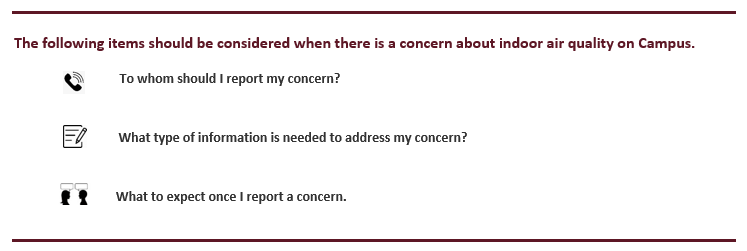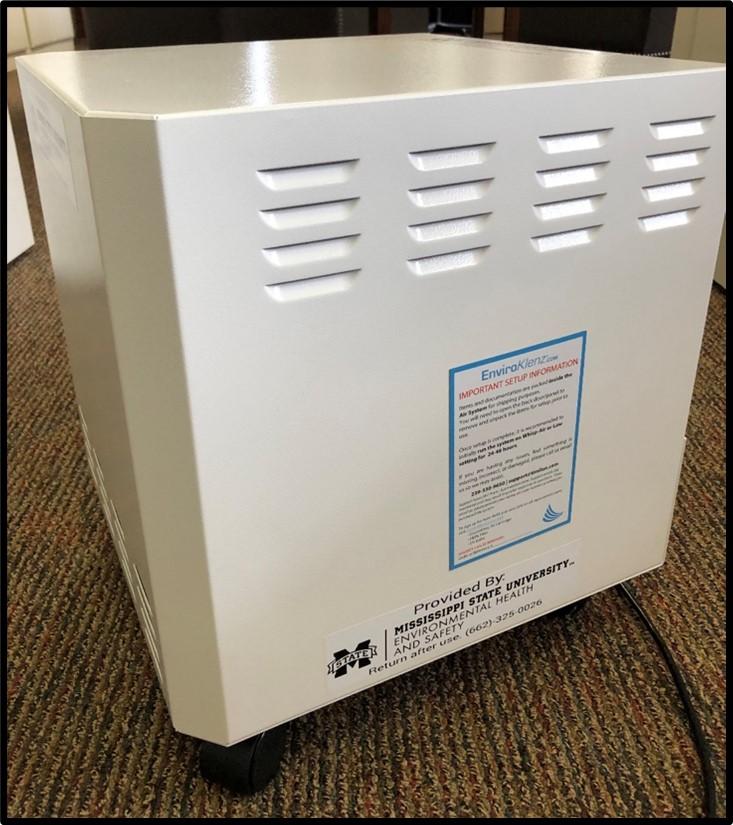Mississippi State University is committed to providing a comfortable environment for students, faculty, and staff. This reference guide has been developed for the purpose of preventing, reducing the incidence, and mitigating indoor environmental quality (IAQ) concerns.
SCOPE:
This guidance document pertains to the air quality of indoor spaces that are serviced by heating, ventilation, and air conditioning (HVAC) systems. This may include office buildings, classrooms, laboratories, residence halls, and other indoor spaces. Indoor air quality does not encompass outdoor work-areas, barns, unfinished construction projects, and other sites that are not serviced by functional HVAC systems.
Common IAQ concerns include:
- Foul odors
- Mold
- Suboptimal temperatures
- Inadequate humidity
- Air contaminants (chemical fumes, particulates, etc.)
RESPONSIBILITIES:
Building Occupants:
Building occupants uphold a responsibility for personal health and safety, as well as ensuring a supportive environment for fellow students/employees and the campus community. In the performance of their duties, occupants are expected to observe safe and healthy work practices. The following list details steps that may be taken to support healthy IAQ:
Clean-up any spills or leaks immediately.
Spills and leaks not only risk damaging building integrity, but may support the growth of harmful microorganisms. Spills should be immediately cleaned and porous materials should not be allowed to remain saturated for prolonged periods. Any leaks should be reported to Facilities Management for repair.
Eat/drink in designated areas.
Eating/drinking should be limited to designated areas to reduce opportunities for pests/vermin. Moreover, food crumbs and debris support the growth of harmful microorganisms.
Limit the amount of clutter.
Clutter enables the collection of dust, pollen and particulates. Excess supplies and personal items stored on the floor or on open shelves make it difficult to adequately clean a room. Additionally, clutter may obstruct airflow and circulation. Closed cabinets are preferable for storage rather than open shelving.
Do not alter or block air flows to and from air conditioning diffusers.
Obstructing air vents may hinder HVAC performance and impair IAQ.
Keep doors and windows closed.
Depending on the type of air conditioning system, it may not be possible to open windows and doors without affecting air flows and temperatures throughout the whole system. This is particularly imperative in laboratory settings. If the room is equipped with an air purifier, it is important to note that filtration efficacy varies from unit to unit. For more information, please refer to the Air Purifier section detailed below.
Be mindful of fragrances and cologne.
Volatile organic compounds (VOCs) are emitted by a wide array of products, including perfumes, colognes, and air fresheners. VOCs may also be emitted by household products such as paints, detergents, cleaners, and building materials/furnishings. Specific VOC compositions and concentrations may cause adverse health effects on an individualized basis. Bear in mind that VOCs resulting from powerful fragrances may trigger asthma or other respiratory conditions.
Do not over water potted plants.
Eliminate standing water in the bottoms of plant pots. Potted plants and other saturated environments can be a significant source of mold in an indoor environment. Additionally, saturated soil may provide a breeding ground for insects and other pests.
Properly maintain sink and floor drains.
Sewer gas odor issues are often due to dried out sink or floor drain traps. Pouring a bucket of water into a floor drain or running the water in a sink for a minute or two will often eliminate the odor.
Properly store wet or damp items.
Storing wet or damp items is an invitation for mold and mildew. Only store items (such as clothes, shoes, umbrellas, etc.) when they are completely dry. Be mindful of keeping damp clothes (such as gym clothes or rain-soaked clothes) in bags or laundry hampers for extended periods of time.
Wash hands frequently.
As a supplement to proper air filtration, hand washing helps prevent the spread of infectious illnesses such as the flu and colds.
Environmental Health & Safety (EH&S):
EH&S is a primary point of contact regarding IAQ concerns and serves as a key resource for mitigating IAQ issues. Depending upon the nature of the issue, EH&S may communicate means for further evaluation and/or provide recommended steps for resolution.
Facilities Management:
Facilities Management or your building maintenance staff are responsible for maintaining each site in a condition that supports optimal IAQ. Facilities Management is accountable for ensuring optimal IAQ parameters as well as resolving/remediating IAQ issues. This includes the maintenance and repair of components associated with both the interior and exterior of a building.
PROCEDURES:

To whom should I report my concern?
- If the nature of the concern is strictly pertaining to comfort or mechanical in nature, (e.g. temperature is too high or low for general comfort, HVAC failure, replacing supply filters, etc.), the concern should be directly reported to Facilities Management via a Service Request or to your accountable building maintenance support staff.
- If the nature of the complaint is health and safety related, the IAQ concern should be reported to EH&S through either submission of a Safety PAWS submission or via Service Request Form.
What type of information is needed to address my concern?
- Provide your contact information so that we may get in touch with you in case we need further details or clarifications.
- Provide the building and room number of the occurrence.
- Describe, in detail, the nature of the IAQ concern.
- Ability to attach accompanying files/pictures, if pertinent.
What to expect once I report a concern.
- If the nature of the complaint is health and safety related and has been reported to EH&S, a field investigation will be completed by the EH&S. A written summary outlining the findings of the EH&S investigation and any relevant recommendations will be disseminated to the appropriate parties.
- Although air sampling might seem to be the logical first response to an indoor environmental quality problem, such an approach is usually not required to solve the problem and can even be misleading. Air sampling should not be considered until some or all of the other investigative activities have been used to collect information related to the concern. Various direct reading survey instruments are typically used to provide a characterization of an indoor environment. In most cases, the information provided during this initial survey is sufficient to identify any problems that may be responsible for the IAQ concerns.
- When air sampling is proposed, a sampling strategy must be developed that is based on a comprehensive understanding of how the building operates and the nature of the concerns.
MOLD:
What enables mold to grow?
- Mold and mold spores can be found almost anywhere and are capable of growing on most organic surfaces.
- When mold spores are exposed to wet/humid indoor areas they can begin to grow or colonize.
- It is virtually impossible to entirely eliminate mold and mold spores in the indoor environment due to daily human activity and the operation of building ventilation systems.
How to minimize mold growth?
- Moisture control, air circulation and good housekeeping practices are necessary to control mold growth.
- Maintaining a clean indoor environment reduces opportunities for mold to grow. Additionally, good housekeeping can better reveal potential underlying facility issues that may promote mold growth.
- Insufficient moisture control is one of the most significant causes of mold growth. This can be attributed to water damage, inadequate humidity control, or elevated and prolonged dampness.
Can exposure to mold cause potential health effects?
- Potential health effects to mold exposure largely vary from person to person.
- Some individuals may not experience any sensitivities to mold exposure; whereas, others may experience a wide range of health effects.
- Common adverse health effects to mold exposure include allergic reactions, asthma, and other respiratory complaints.
Why isn't mold testing recommended?
- There are no federal or state regulations governing the presence of mold or mold spores in buildings. There are also no health standards from the Centers for Disease Control and Prevention (CDC) or public health departments for concentrations of mold spores in the indoor air.
- The CDC and EPA do not recommend testing as there are no exposure-based standards to use for evaluation of the sampling results. Read more on mold testing from the EPA.
- Due to the absence of defined standards as further compounded to variable personal susceptibility/tolerance, mold testing is not recommended in many cases.
- Rather, the presence of visible mold on indoor building materials should be remediated.
How to remediate mold?
- To remediate mold concerns, the initial goal aims to address the underlying moisture control issue.
- Per ASHRAE Standard 8, indoor relative humidity should not exceed 60%. As supported by the American Society of Microbiology, optimal indoor relative humidity should fall within 40%-60% to minimize adverse health effects and limit the propagation and persistence of harmful microorganisms, including mold.
- After addressing humidity control issues, EH&S recommends mold remediation by Facilities Management personnel, building maintenance staff, or professional contracted vendors. In brief, EH&S recommends the following mold remediation actions:
- Removal and/or encapsulation of visible mold on solid surfaces. Due to the potential to cause surface damage and produce harmful vapors in an indoor environment, bleach should not be used for mold remediation. If the mold growth exceeds 10 square feet, EH&S recommends contracting the remediation to a professional service provider.
- Repair leaks and remediate impacted environments. Temporary use of dehumidifiers may be necessary to facilitate the drying of saturated materials, such as carpets or upholstery.
- If carpets are steam cleaned, it is imperative to stage the area with dehumidifiers to avoid prolonged saturation.
- Assess HVAC ductwork and fumigate if deemed necessary. Fumigation should be performed by a professional service provider.
AIR PURIFIERS:
In an indoor office setting, air purifiers may be used to capture particulates (such as dust, pollen, mold spores, and other harmful microorganisms). It is important to note that only high efficiency particulate air (HEPA) purification systems are suitable for indoor air filtration. No other type of filtration units (including ozone, UV, ionic, etc.) are acceptable to supplement IAQ. A reccomended air filtration unit is shown below and can be ordered from a varity of sources inculding thorugh Amazon Business in BullyBuy by searching EnviorKlenz.
While mold remediation is underway or for other airborne particulate contaminants are of concern, EH&S may offer temporary use of a high efficiency particulate air (HEPA) purification unit.

Questions?
If you have any questions or would like to request additional information, please contact Environmental Health and Safety: ehs@msstate.edu / 662-325-0026.